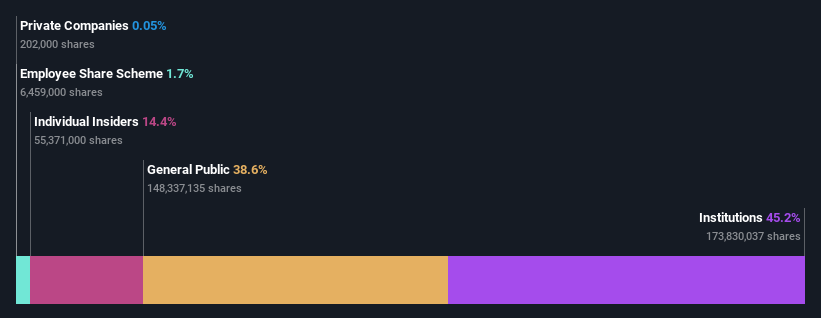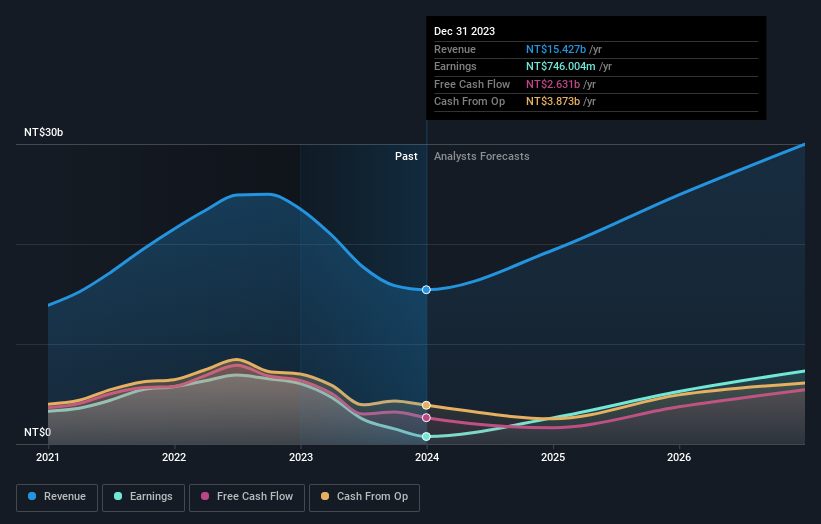Stock Analysis
- Taiwan
- /
- Semiconductors
- /
- TWSE:6415
Positive week for Silergy Corp. (TWSE:6415) institutional investors who lost 22% over the past year

Key Insights
- Institutions' substantial holdings in Silergy implies that they have significant influence over the company's share price
- The top 22 shareholders own 51% of the company
- 14% of Silergy is held by insiders
Every investor in Silergy Corp. (TWSE:6415) should be aware of the most powerful shareholder groups. We can see that institutions own the lion's share in the company with 45% ownership. Put another way, the group faces the maximum upside potential (or downside risk).
Institutional investors would appreciate the 21% increase in share price last week, given their one-year losses have totalled a disappointing 22%.
Let's take a closer look to see what the different types of shareholders can tell us about Silergy.
View our latest analysis for Silergy

What Does The Institutional Ownership Tell Us About Silergy?
Many institutions measure their performance against an index that approximates the local market. So they usually pay more attention to companies that are included in major indices.
We can see that Silergy does have institutional investors; and they hold a good portion of the company's stock. This suggests some credibility amongst professional investors. But we can't rely on that fact alone since institutions make bad investments sometimes, just like everyone does. If multiple institutions change their view on a stock at the same time, you could see the share price drop fast. It's therefore worth looking at Silergy's earnings history below. Of course, the future is what really matters.

Hedge funds don't have many shares in Silergy. Wei Chen is currently the company's largest shareholder with 7.3% of shares outstanding. With 3.9% and 3.6% of the shares outstanding respectively, Budong You and T. Rowe Price Group, Inc. are the second and third largest shareholders. Budong You, who is the second-largest shareholder, also happens to hold the title of Chief Executive Officer.
A closer look at our ownership figures suggests that the top 22 shareholders have a combined ownership of 51% implying that no single shareholder has a majority.
While studying institutional ownership for a company can add value to your research, it is also a good practice to research analyst recommendations to get a deeper understand of a stock's expected performance. There are a reasonable number of analysts covering the stock, so it might be useful to find out their aggregate view on the future.
Insider Ownership Of Silergy
The definition of an insider can differ slightly between different countries, but members of the board of directors always count. Management ultimately answers to the board. However, it is not uncommon for managers to be executive board members, especially if they are a founder or the CEO.
I generally consider insider ownership to be a good thing. However, on some occasions it makes it more difficult for other shareholders to hold the board accountable for decisions.
Our most recent data indicates that insiders own a reasonable proportion of Silergy Corp.. Insiders own NT$21b worth of shares in the NT$149b company. That's quite meaningful. It is good to see this level of investment. You can check here to see if those insiders have been buying recently.
General Public Ownership
With a 39% ownership, the general public, mostly comprising of individual investors, have some degree of sway over Silergy. While this group can't necessarily call the shots, it can certainly have a real influence on how the company is run.
Next Steps:
While it is well worth considering the different groups that own a company, there are other factors that are even more important. Case in point: We've spotted 2 warning signs for Silergy you should be aware of.
Ultimately the future is most important. You can access this free report on analyst forecasts for the company.
NB: Figures in this article are calculated using data from the last twelve months, which refer to the 12-month period ending on the last date of the month the financial statement is dated. This may not be consistent with full year annual report figures.
Valuation is complex, but we're helping make it simple.
Find out whether Silergy is potentially over or undervalued by checking out our comprehensive analysis, which includes fair value estimates, risks and warnings, dividends, insider transactions and financial health.
View the Free AnalysisHave feedback on this article? Concerned about the content? Get in touch with us directly. Alternatively, email editorial-team (at) simplywallst.com.
This article by Simply Wall St is general in nature. We provide commentary based on historical data and analyst forecasts only using an unbiased methodology and our articles are not intended to be financial advice. It does not constitute a recommendation to buy or sell any stock, and does not take account of your objectives, or your financial situation. We aim to bring you long-term focused analysis driven by fundamental data. Note that our analysis may not factor in the latest price-sensitive company announcements or qualitative material. Simply Wall St has no position in any stocks mentioned.
About TWSE:6415
Silergy
Silergy Corp. engages in the research, design, development, and sales of various integrated circuit products and related technical services in China and internationally.
Adequate balance sheet with moderate growth potential.

